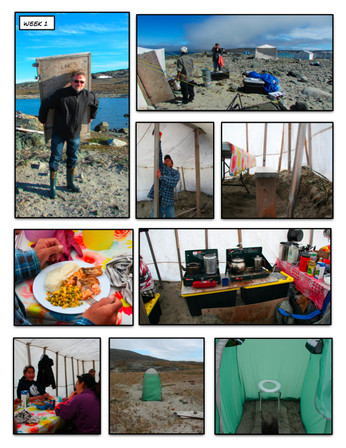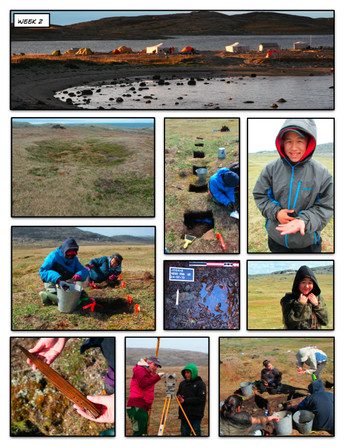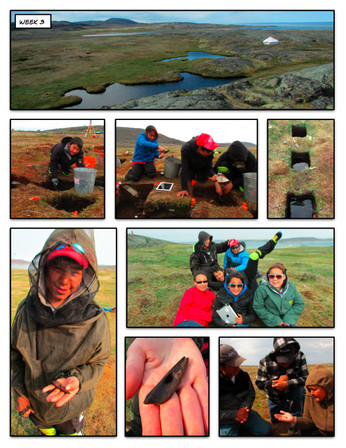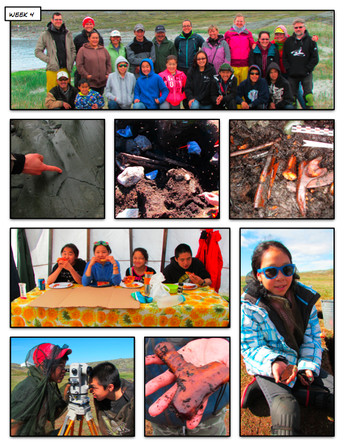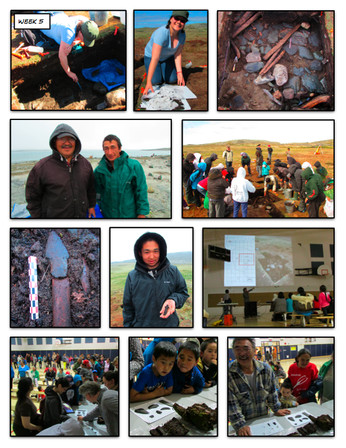Avataq archaeology school on Qikirtajuaq: field diary
Par Qikirtajuaq archeology field school team
Week 1 (July 14-20): Qikirtajuaq Turkish style!
It’s four degrees and windy, but the cold does not keep us from moving the field equipment to Qikirtajuaq, also known as Cape Smith, an island near Akulivik. Our tents are old, as some were used for the first time in 2007 during another field school near Inukjuak. We are expecting the tents to be leaking, so we added some plastic tarp on top. The camp is at the foot of the valley that leads to the Kangiakallak 1 site (JeGn-2) where we are currently excavating.
We have a large kitchen tent that can seat 20 people around three tables. To get the tent roof high enough to walk around inside comfortably, we had to excavate the floor by 30cm. There are some kitchen rules. You can only enter if you wash your hands before. Better be safe than sorry! On the menu this week: geese, arctic char, fresh mussels, and of course the traditional soup and sandwich.
The second largest tent is the lab. It is used for the storage of equipment and the artifacts. The students from Akulivik have middle sized tents and the camp also includes individual tents. Last, but not least, we have a field toilet, a small tent, with a hole dug up and two pieces of wood on each side to stand on – Turkish style - or to be used with a toilet seat on legs if you like luxury. Some also prefer to take a walk or use the automatic flush toilet – natural model – at the tip of the island.
Week 2 (July 21-27): Some smelly ones
Kangiakallak 1 site (JeGn-2) was occupied initially by Dorset people who built winter houses characterized by shallow depressions, more or less rectangular in shape, and rarely more than 30 cm deep. Later, Inuit settled at the same site, at least 200 years ago. Their winter houses were different, semi-subterranean with tunnel entrance. For building their houses they used the sod that was filled with Dorset artifacts resulting in a mixing of material cultures by the time they were abandoned.
Akulivik students are currently learning all aspects of field work, such as mapping of the site, the excavation of squares, the collection of artifacts, including water sieving, and the pre-treatment of artifacts in the field laboratory. Summer with Avataq is an intense experience, but as everything should have an end, the curfew is at 23h despite the bright sun still on the horizon. The day starts at 8h in the kitchen. Sometimes it is awfully quiet, but if ready, the students get pancakes, eggs, etc. Most students rush in around 8h45, however, just in time for a quick bowl of cereal or oatmeal, before climbing the hill to reach the site. Among the tasks for the day - drawing of artifacts in situ (scale 1:10) or using the theodolite, a skill to be developed.
They also become researchers by doing their own study, including the documentation of the excavation and of the work of archaeologists by taking pictures and filming, asking questions or by observing. From morning to sometime late at night, our island is filled with laughing, storytelling and games during our spare time. Nothing better than spending some good time without TV or Internet!
The nicest finding this week is probably the one of old sled runner inside a lake at the north-western part of the island. The wood is amazingly well preserved with a fresh look, just like it had been carved a few days ago. By contrast, the ugliest findings of the week are the two excavated squares characterized by suspicious dirty grey sand, retaining the smell of hundreds of years old igunaq (fermented sea mammal). Apparently they forgot their last snack before moving to their spring camp…
Week 3 (July 28- August 3): When stars eat fish
The “Avataq School” not only consists of learning how to excavate a site. It is also about presentations held in our kitchen tent, especially when the weather is uncooperative. So far, the students have been introduced to the local history by Juanasi Qaqutuq, they learned about a recent project concerning Nunatop (place name database) by Elsa Cencig (Avataq archaeologist), they were presented a history of archaeology in Nunavik and about ancient people of the Arctic by Pierre Desrosiers (Avataq archaeologist), and were introduced to Syrian prehistory by Ruth Mienert (University student from Switzerland).
The students also worked with Jessica Kotierk (Canadian Conservation Institute), who introduced them to the treatment and cleaning of the artifacts in the field laboratory - meticulous work, but far from the mosquitoes or the cold wind! They also made Power Point presentations with the many great pictures they took, with Jrene Rahm (teacher, Montreal University). Finally, they learned how to do their dishes after eating, what a relief for Laina Anauta, the cook. At night, they played games, listened to presentations, made jokes, and sometimes, after curfew… raided the kitchen for a midnight snack! In brief, nothing unusual for a long camping field school.
The day can sometimes be boring, uncovering many similar bones, then sieving, and then excavating again, while being a treat to the large hordes of mosquitoes, just minutes after your own blood and body is getting back to life, given its previous frozen state due to the cold wind. All this became the daily routine, until… a harpoon head suddenly popped up in one of the squares! This was enough to light the flame again! And the archaeology fever was back, with students accelerating their excavation work with the hope to find more. And then, it paid off! Just the next day, another harpoon head! As we say, all good things come in threes, so much more to come next week for sure.
Juanasi Qaqutuq and Simon Echalook, our hunter-guide and assistant, also made an interesting discovery while emptying the fish net. One fish had two starfish stuck to it. When removing them, they found a big hole in the fish, so definitively stars eat fish.
Week 4 (August 4-10): The Unexpected
One important aspect of the project concerns a team of geographers from Laval University, Centre for Northern Studies: Najat Bhiry, Dominique Todisco, Sebastien Lafrance and Annie-Pier Trottier. They are studying the land formation process in the surrounding area of the site. They also study how the archaeological sites have been buried in the ground. One of the interesting aspects of their study is the abundant presence of drift wood on the site used for the construction of the houses. Where did this wood originate? How and where was it collected? These are some of these questions currently under study.
One of the things that unfortunately almost always happens while camping is things that break, and then make your life uncomfortable, like an air mattress that loses its air… or the zipper of the field toilet that no longer preserves your privacy … But don’t worry; Simon will fix it! Simon is our handyman, he can fix almost anything!
With the music festival going on in Akulivik, the week was composed of archaeology during the day and music at night. It was an eventful week, with mosquitoes, loud music, squares getting deeper and deeper, long evenings, early mornings with little eyes… but also a series of amazing discoveries. In the middle of the Inuit winter house, under a series of layers containing mainly Dorset artifacts, bones and burn fat, we discovered a layer of fresh bones lying just on the surface of the floor. The bones are so fresh that some still show signs of putrefaction. Among them was an amazing piece, a handle probably of a panak (snow knife), with carved marks. Finally, just before we left this Friday, we found a piece of fur skin underneath!
One of the questions archaeologists most often get is probably: What would you consider an amazing discovery? The best answer would probably be: the unexpected!
Week 5 (August 11-17): Skin Care and Display
The last week was a frantic one with amazing discoveries one after the other. With these discoveries comes the responsibility of preserving them and of properly recording each of them.
Skin care: Oily, dry or sensitive skin, there is a solution for every skin problem... What about hairy rotten skin just unfrozen after hundreds of years? This was a problem we had to face after unearthing patches of skin fur stuck onto the paved stone floor of the excavated qarmaq. To solve this problem, Jessica slowly detached the bottom of the skin from the stone and slid plastic underneath it. It was then possible to slide a plastic board and lift it.
Time for the display: two activities were held during the final week of our excavation. First, on the previous Sunday, a religious service was organized on the island followed by a guided tour at the site by Tommy Weetaluktuk (Avataq archaeologist). A presentation of the preliminary results from the excavation and an exhibit of artifacts were also organized on Friday the 16th at the Tukisiniarvik School. The two activities were attended by numerous people. Among the items on display were some of last week’s discoveries: a stone knife with a wooden handle, a needle, a baleen string with a knot, a large harpoon head, and a wooden doll.
This project would not have been possible without the support of Akulivik people and of our 12 students: Louisa Aullaluk, Ittuvik Anautak, Simionie Qinuajuak, Maggie Irqumia, Sandy Qungisiruk-Iyaituk, Timangiak Novalinga, Jeannie Qinuajuak, Laura Aliqu, Thomas Alayco, Lucassie Aullaluk, Illutak Anautak and Nancy Alayco. The project was to permit Inuit to conduct their own research in documenting their history. We received strong support from Qekeirriaq Landholding Corporation, who provided us with transportation, and from Kativik School Board, who provided us with a house and the opportunity to do a presentation at the school. The support of the NV was also greatly appreciated. The Akulivik students were employed thanks to the KRG summer job program. The camping (food, equipment, etc.) and part of the transportation (cargo, plane) was financed by a federal grant (http://www.sshrc-crsh.gc.ca/) that was obtained by Avataq, and by a research grant from France (http://www.institut-polaire.fr/). Also, a project to get the local students involves in the preservation and documentation of their history was financed by another federal grant (SSHRC).

